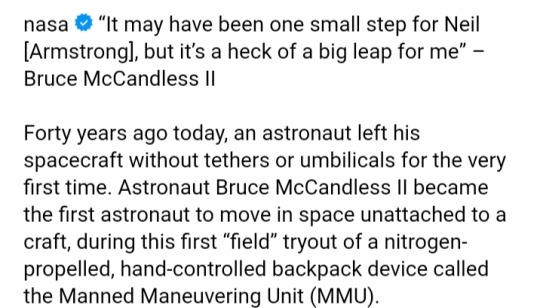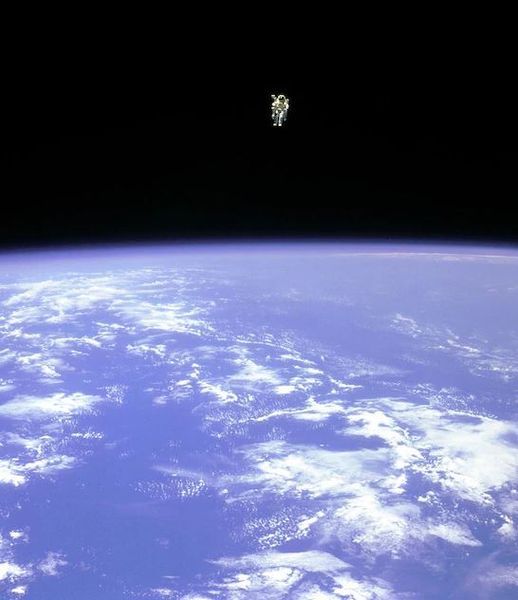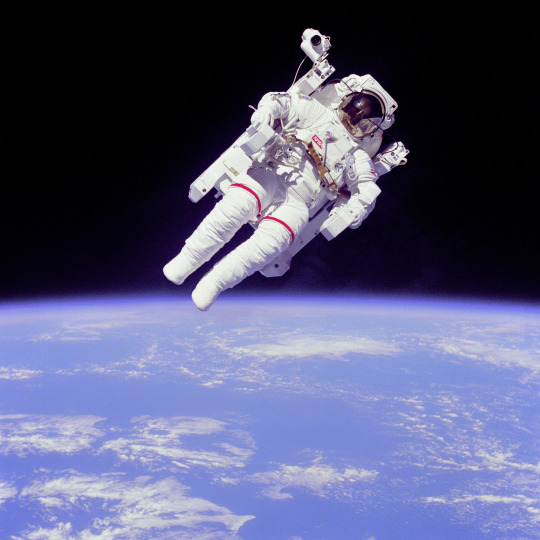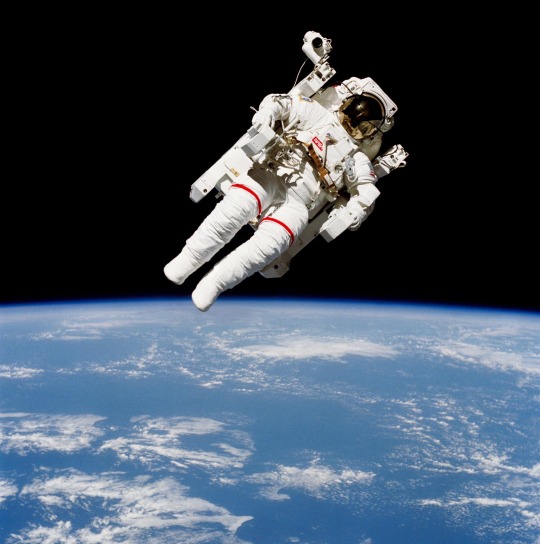#untethered spacewalk
Text
Astronaut Bruce McCandless Performs the First Untethered Spacewalk - February 7, 1984
0 notes
Text




7 February 2024
—
Bruce McCandless II (born Byron Willis McCandless; June 8, 1937 – December 21, 2017) was an American Navy officer and aviator, electrical engineer, and NASA astronaut.
On 7 February 1984, during the first of his two Space Shuttle missions, he completed the first untethered spacewalk by using the Manned Maneuvering Unit.
#Bruce McCandless II#astronaut#spacecraft#space#Manned Maneuvering Unit#Robert L. Gibson#Hoot#Earth#space photography#NASA#universe#cosmos#Space Shuttle Challenger#First Untethered Spacewalk#spacewalk
45 notes
·
View notes
Text

First untethered space walk, 1984
#Nasa#untethered#space#spacewalk#challenger#Buck Rogers jet pack#Astronaut#1984#apollo#heroism#space travel#to the moon#ISS#neil armstrong#Alexei Leonov#Cosmonaut#project gemini#Bruce McCandless#space shuttle
4 notes
·
View notes
Text

Bruce McCandless floats freely in space with Earth 170 miles beneath him. NASA
The Inside Story of the First Untethered Spacewalk
On February 7, 1984, astronaut Bruce McCandless ventured out into space and away from Shuttle Challenger using only a Nitrogen-Propelled, hand-controlled backpack
— May 8, 2024 | Adam Higginbotham
The first space shuttle mission of 1984, the launch of Challenger on the cool, windless morning of Friday, February 3, was apparently perfect—and eagerly trailed by a national press anticipating the first flights of what they called the “Buck Rogers jetpacks.” Formally known as the Manned Maneuvering Unit, the invention was a massive backpack equipped with gas thrusters that would allow astronauts to leave their spacecraft and float free in space for the first time in history. Reporters hoped that the spectacle would approach the theatrics of watching men walk on the moon more than a decade before. But, once in orbit, as the astronauts tackled the initial tasks of their weeklong mission, they experienced a trickle of humiliating failures: First, mission specialist Ronald E. McNair oversaw the launch of the Westar 6 communications satellite, which spun like a top out of the payload bay as planned, but then apparently vanished. Mission Control sheepishly admitted that they had simply lost it somewhere in space. “We can’t find it,” they told the astronauts over the radio link. “It’s not where it’s supposed to be.”
Then an experiment designed to test the shuttle’s facility for orbital rendezvous, using a Mylar balloon inflated with gas, also ended in farce when the balloon launched but promptly exploded; meanwhile, the shuttle toilet—which had always been troublesome—stopped working altogether. After waiting 48 hours to assure themselves that Palapa B-2, the second satellite due for release on the mission, would not suffer a similar fate to Westar 6, Mission Control gave the crew instructions to proceed with launching it. Seconds later, they lost contact with that, too. The total bill for the two mislaid satellites was at least $180 million.
By the time two men—Colonel Robert L. Stewart and Captain Bruce McCandless, one of the veteran astronauts who had signed on to NASA during the Apollo program and waited 18 years for this moment—stepped into the air lock to test the Manned Maneuvering Unit on the fifth day of the mission, NASA was desperate for good publicity.

The crew on Challenger, from top right counter clockwise; Vance D. Brand, Robert L. “Hoot” Gibson, Ronald E. McNair, Bruce McCandless and Robert L. Stewart NASA
They were not disappointed. At 7:25 on Tuesday morning, Houston time, McCandless fired the thrusters of his jetpack, rose slowly from Challenger’s cargo bay and flew clear of the spacecraft. He ran through his flight checklist, touching the joysticks with his fingertips to verify that the pack was working as it should: “Pitch down, pitch up, roll left, roll right,” he began, enunciating each word clearly into his headset microphone. Behind him, the pack trembled and shuddered like a nervous pony as its onboard computers automatically corrected his attitude with tiny whispers of gas from its two dozen nitrogen jets. Despite all his years of training and the bitter cold inside the suit, his palms prickled with sweat; his heart quickened. “It may have been a small step for Neil,” he said, “but it’s a heck of a big leap for me.”
Moving backward at no more than a foot a second, to preserve valuable fuel, McCandless watched as the gulf separating him from Challenger steadily expanded. Inside his suit, it became so cold his teeth began chattering; he switched off the internal cooling unit and continued sailing out into space. He looked for stars but saw only an enveloping darkness. The astronaut held a crude range finder—an aluminum bar etched with marks against which to measure his diminishing view of the shuttle’s cargo bay—to estimate the distance from the orbiter, and make sure he didn’t stray too far. Inside the cabin, McNair stood at the controls of the shuttle’s robot arm, ready to snatch McCandless to safety if necessary, and kept a laser tracker and Challenger’s TV cameras trained on him, transmitting live pictures to Houston and television stations around the planet. Meanwhile, Stewart remained behind in the payload bay, conducting a separate series of tests.
Still gazing back toward the shuttle, McCandless at last reached his destination and brought the jetpack’s progress to a halt: some 320 feet out in space, 170 miles above the Atlantic—a human satellite in orbit, traveling at 23 times the speed of sound. Yet the astronaut felt no sense of movement until he looked down and saw the planet rotating beneath his feet, a pin-sharp relief map unspooling at four miles per second: “Looks like Florida. It is Florida!” he said, his composure ebbing momentarily as he spotted Cape Canaveral below. “It really is beautiful.”
Looking out from the cockpit, pilot Robert L. “Hoot” Gibson centered the distant figure in the viewfinder of his Hasselblad—but then pulled the camera away from his eye, briefly startled by the power and clarity of the image he had framed. Gibson saw McCandless suspended alone in the abyssal blackness—angled slightly from the vertical, his white suit seeming to glow beneath the unfiltered sunlight of outer space, the luminous blue band of Earth’s atmosphere curving away beneath him. Gibson checked the settings on the camera, and then checked them again; he pointed the lens through the triple-paned cabin window and tilted it to level the horizon. He squeezed the shutter.
Meanwhile, McCandless continued to test the abilities of his experimental flying machine: He sailed back toward Challenger and then drew away once more; he dipped and rose, and turned somersaults. Like the other astronauts before him who had spoken rapturously of walking in space—back in 1965, Ed White had been so reluctant to return to his Gemini capsule that he described doing so as “the saddest moment of my life”—McCandless had hoped, if only for a few moments, to experience the noiseless solitude of being alone in the heavens; but the relentless chatter of the three audio feeds in his headset made it impossible.

McCandless in space NASA
The experimental plan had called, too, for the astronaut to orient himself to turn away from the shuttle when he reached the limit of his journey, and face out into the void. McCandless, a grizzled and shaven- headed 46-year-old third-generation Navy officer whose father and grandfather had both been awarded the Medal of Honor, was well acquainted with the limits of fear; as a Naval aviator, he had often landed his Phantom on the pitching deck of a carrier at night, and he believed that he would never do anything more dangerous. Yet, despite his intentions, not once in the entire spacewalk did he turn his back on Challenger, his sole means of returning home.
Almost six hours after their experiment had begun, McCandless and Stewart clambered back inside the spacecraft, sealed the door of the air lock behind them and removed their helmets. Down in Mission Control, the two astronauts’ wives fell into each other’s arms and wept.
— Excerpted from Challenger: A True Story of Heroism and Disaster on the Edge of Space by Adam Higginbotham. Published by Avid Reader Press / Simon and Schuster.
#Austronauts#Explorer 🧭#Innovation#NASA#Outer Space 🪐#Space#Travel 🧳 🧭#Technology#First | Untethered | Spacewalk#Bruce McCandless#Shuttle Challenger#Nitrogen-Propelled#Smithsonian
2 notes
·
View notes
Text

1 note
·
View note
Text
Hardly Frightening!
Bruce McCandless – Feb. 7, 1984
This photo is often shared and referred to as a “frightening picture”. From the first time I saw this (which happened 40 years ago this Feb. 7) I found it both thrilling and a testament to what human ingenuity can accomplish. To me it also represents how, despite his apparent loneliness in the vastness of space, it took his crew, the NASA team below, and thousands…

View On WordPress
#astronaut#Challenger#ingenuity#Manned Maneuvering Unit#McCandless#MMU#space#Space Shuttle#Spacewalk#Stewart#STS-41B#Untethered
1 note
·
View note
Text

This iconic photograph is still considered one of the most-terrifying space photographs to date. Astronaut Bruce McCandless II became the first human being to perform spacewalk without a safety tether linked to a spacecraft. He floated completely untethered in space with nothing but his Manned Maneuvering Unit keeping him alive.
58 notes
·
View notes
Text

My first Kickstarter, The Edge of Survival is now live!
Play as an astronaut untethered from your ship in a solo journaling RPG of dire circumstances, of desperation and hope. 👩🚀
#ttrpg#kickstarter#solo journaling game#solo journaling rpg#space#I'm pretty hype about it; so even if you check it out that'd mean a lot!
56 notes
·
View notes
Text

This Day in History: First untethered spacewalk
On this day in 2017, a pioneer passes away. Bruce McCandless II is best known as the NASA astronaut who made the first untethered spacewalk.
No one had ever done such a thing before. Usually, a long cable keeps astronauts safely bound to their spacecraft. But on February 7, 1984, Captain McCandless would leave the Space Shuttle Challenger and float freely in space, relying only on a propulsion system strapped to his back.
McCandless had been in Mission Control when Neil Armstrong accomplished a similar feat on the moon’s surface. Now, nearly 15 years later, it was his turn.
“It may have been one small step for Neil,” McCandless joked as he left the Space Shuttle that day. “But it’s a heckuva big leap for me.”
The story continues here: https://www.taraross.com/post/tdih-challenger-spacewalk
#tdih#otd#this day in history#history#history blog#America#nasa#space#aviation history#sharethehistory
120 notes
·
View notes
Text

This iconic photograph is still considered one of the most-terrifying space photographs to date. Astronaut Bruce McCandless II became the first human being to do a spacewalk without a safety tether linked to a spacecraft. In 1984, he floated completely untethered in space with nothing but his Manned Maneuvering Unit keeping him alive.
53 notes
·
View notes
Text

Floating Free in Space - June 14th, 1996.
"NASA astronauts can float free in space without any connection to a spaceship. Here, astronaut Bruce McCandless maneuvers outside the Space Shuttle Challenger by firing nitrogen gas thrusters on his manned maneuvering unit (MMU). This picture was taken in 1984 and records this first untethered spacewalk. The MMU was developed because astronauts found tethers restrictive."
21 notes
·
View notes
Text

This iconic photograph is still considered one of the most-terrifying space photographs to date. Astronaut Bruce McCandless II became the first human being to do a spacewalk without a safety tether linked to a spacecraft. In 1984, he floated completely untethered in space with nothing but his Manned Maneuvering Unit keeping him alive.

23 notes
·
View notes
Text

(3 days before flight)
"Rocky, should I untether Mark from the pipes?"
"Don't even think about it Sebastian. I don't want to get into trouble !"
»»» 11th Day of Mission
Load LOG : // SL-21-20XX-28-12_01…
(alternate title : fuck characterisation, hello OOC. get OOC pain'd.)
###########
23:04:26:85 UTC +1 CET
Recording? Ok...so today-
("Talking into your diary again like a girl, love? ")
"Fucking…" clunk "It's my logging session. I'll throw something at you."
("Did you forget where you are?")
"Fick dich."
("…I hope that's German for 'I like you a lot?' ")
< clunk >
recording terminated due to lack of sound / voice activity.
###########
END LOG SL-21-20XX-28-12_01
// -----------------------------
Load LOG : // SL-21-20XX-28-12_02…
###########
23:11:33:02 UTC +1 CET
…Ok, the light is on, it is recording now.
This morning the Earth looked bluer than usual, and I really liked it, so I grabbed the camera and quickly snapped a picture. My photography skills are good enough!

NASA's Jackson called us the noisiest astronauts ever. Fair... But he did remark on how efficiently Mark and I get the work done around the station, given the state and the age of the machines. We would really just split the massive amount of maintenance into two and made sure we tied up any loose ends, and they were always impressed.
Today we had to do a pretty massive job of putting on the NOAX stuff on the many of the station panels. It was our second time doing a spacewalk in only eleven days, so that's a big thing. And it was…four hours outside, putting basically space caulk. Heat really gets to these big guys! The application was less than fantastic though, as we had to use spatulas to put them on…it was a really careful science experiment. There's Mark and me, stuck to only the metal railings of the station for our lives, putting state-of-the-art things with some ma's spatula. It's hot doing this the whole day, just mashing this stuff in! Sweating in space is not fun…
I looked up the stuff when I got back from the work. They use these things in Formula 1 cars…? Well you learn something new everyday and experience new things too, but I'm not sure how this caulk thing will benefit that much… probably only useful if Michael Schumacher goes 27 thousand kilometres per hour, sure…

Ok, I have been putting off talking about Mark.
The previous recordings already have them, but for memory's sake, I will just mention it here. I know, I know, I'm going to be 24 next year, and here I am, still feeling like i'm in middle school with how I'm acting.
We've been co-workers for two years now, and we've had our fair share of being at each other's necks. Horner didn't help either. The only thing he had to say to us before we left was that we were like an old married couple. And to get "our shit sorted by the end of the trip".
Well…
It really is hard to put it into words. It was pretty obvious to everyone, so I am the idiot here. Hah... I tried not to think much of it, especially during the suit up procedure for the spacewalks. it needed two people anyway.
Before we went back into the airlock, the bastard went to unhook my tether off the metal railing! Fucker!! Do you know how screwed we'll get if I wasn't anywhere with the EMU? He had the gall to laugh in his suit. I should have just beaten his face in just now.
("You didn't mention me holding your hands?")
clnk
("oh shoot--")
recording terminated due to lack of sound / voice activity.
###########
END LOG SL-21-20XX-28-12-2
----------------

45 notes
·
View notes
Text

Views of the Challenger landing at Kennedy to end shuttle mission 41-B





"Shortly after sunrise the space shuttle orbiter Challenger touches down on the KSC runway at 7:16 a.m. The T-38 escort chase plane is seen just above the orbiter. The historic first landing at KSC brought to a conclusion an eight-day mission that started at 8:00 a.m. Feb. 3, 1984. The STS-41-B mission had several other firsts including an untethered spacewalk made by two of the astronauts."
Date: February 11, 1984
NASA ID: S84-27175, KSC-84PC-0082, KSC-84PC-0121, S84-27717, KSC-84PC-0092, S84-27154
#STS-41-B#STS-41B#STS-11#Space Shuttle#Space Shuttle Challenger#Challenger#OV-099#Orbiter#NASA#Space Shuttle Program#landing#Kennedy Space Center#Florida#T-38#February#1984#my post
27 notes
·
View notes
Text

"The First Untethered Spacewalk", Signed and Inscribed by Mission Specialist 1 Bruce McCandless II
"Oh God, Thy sea is so great / and my boat is so small!"
11 notes
·
View notes
Text
Astronaut Bruce McCandless Performs the First Untethered Spacewalk
Astronaut Bruce McCandless II approaches his maximum distance from the Earth-orbiting Space Shuttle Challenger in this 70mm photo from Feb. 7, 1984. While testing out the nitrogen-propelled, hand-controlled back-pack device called the manned maneuvering unit (MMU) for the first time, McCandless’s fellow crewmembers aboard the reusable vehicle photographed him. The MMU allowed crews to move […]
from NASA https://ift.tt/8eIr062
0 notes